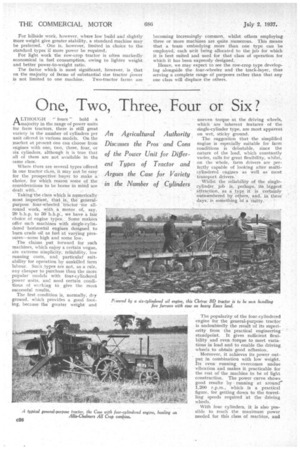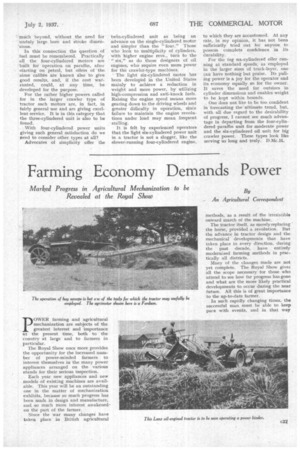One, Two, Three, Four or. Six ?
Page 72

Page 73

If you've noticed an error in this article please click here to report it so we can fix it.
An Agricultural Authority. Discoses the Pros and Cons of the Power Unit for Different Types of Tractor and Argues the Case for Variety in the Number of Cylinders
A LTHOUGH " fours " hold a timajority in the range of power units for farm tractors, there is still great variety in the number of cylinders per unit offered in various models. On the market at present one can choose from engines with one, two, three, four, or Six cylinders, although it is true that all of them are not available in the same class.
Where there are several types offered in one tractor class, it may not be easy for the prospective buyer to make a choice, for which reason some of the considerations to be borne in mind are dealt with.
Taking the class which is numerically most important, that is, the generalPurpose four-wheeled 'tractor -tor allround work, with a motor of, say, 20 b.h.p. to 30 b.h.p., we have a fair choice of engine types.: Some makers offer such machines with siagle-cyliridered •horizontal engines deSigned to burn crude oil as fuel at varying pi-essUres—some high and some low.
The claims put forward for such machines, which enjoy a certain vogue, are extreme simplicity, reliability, low running costs, and particulafsuitability for operation by unskilled farm labour. Such types are not, as a rule, any cheaper to purchase than the more popular models with four-eylindered power units, and need certain conditions of working to give the most successful results.
The first condition is, normally, dry ground, which provides a good footing, because the greater weight and uneven torque at the driving wheels, which are inherent features of the single-cylinder type, are most apparent on wet, sticky ground.
The suggestion that the simplified engine is especially suitable for farm conditions is debatable, since the nature of the load, which constantly varies, calls for great flexibility, whilst, on the whole, farm drivers are perfectly capable of looking after multicylindered engines as well as most transport drivers.
Whilst the reliability of the i singlecylinder. job is, perhaps, its biggest attraction, as a type it is certainly outnumbered by others, and, in these days, is something sof a rarity.
The popularity of the four-cylindered engine for the general-purpose tractor is undoubtedly the result of its superiority from the practical engineering standpoint. It gives sufficient flexibility and even torque to meet variations in load and to enable the driving wheels to obtain good adhesion.
Moreover, it achieves its power output in combination with low weight. Its even running overcomes undue vibration and makes it practicable for the rest of the machine to be of light construction. The power curve shows good results by running at around' 1,200 r,p.xn., which is a practical figure, for getting down to the travelling speeds required at the driving wheels.
With four cylinders, it is also possible to reach the maximum power needed for this class of machine, and
much beyond, without the need for unduly large bore and stroke dimensions.
In this connection the question of . fuel must be remembered, Practically all the four-cylindered motors are biilt fot operation on paraffin, after starting on petrol, but oilers of the "same calibre are known also to give good results, and, if the cost warranted, could, at any time, he developed for the purpose.
For the rather higher powers called for in the larger crawler type of tractor such motors are, in fact, in fairly general use and are giving excellent service. It is in this category that the three-cylindered unit is also to be found.
With four-cylindered power units giving such general satisfaction do we need to consider other types at all?
Advocates of simplicity offer the twin-cylindered unit as being an advance on the single-cylindered motor and simpler than the " four." Those who look to multiplicity of cylinders, with higher engine revs., turn to the " six," as do those designers of oil engines, who require even more power for the crawler-type machines.
• The light six-cylindered motor has been developed in the United States mainly to achieve a reduction in weight and more power, by utilizing high-compression and anti-knock fuels. Raising the engine speed means more gearing down to.the driving wheels and greater difficulty in operation, since failure to maintain the engine revolutions under load may mean frequent It is felt by experienced operators that the light six-cylindered power unit in a tractor is not a slogger, like the slower-running four-cylindered engine, to which they are accustomed. At any rate, in my opinion, it has not been sufficiently tried out for anyone to possess complete confidence in its durability.
For the big six,cylindered oiler running at standard speeds, as employed in the larger sizes of track-layer, one can have nothing but praise. Its pulling power is a joy for the operator and its economy equally so for the owner. It saves the need for outsizes in cylinder dimensions and enables weight to be kept within bounds.
One does not like to be too confident in forecasting the ultimate trend, but, with all due regard to the desirability of progress, I cannot see much advantage in departing from the four-cylindered paraffin unit for moderate power and the six-cylindered oil unit for big crawler power. These types look like serving us long and truly. 1).Mc.I1.




















































































































































